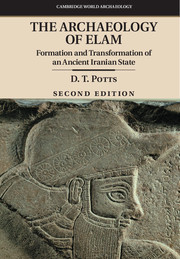Book contents
- Frontmatter
- Dedication
- Contents
- List of illustrations
- List of tables
- Preface to the second edition
- Preface and acknowledgements
- Acknowledgements for photographic reproduction
- List of abbreviations
- Note on transliteration and dating systems
- 1 Elam: what, when, where?
- 2 Environment, climate and resources
- 3 The immediate precursors of Elam
- 4 Elam and Awan
- 5 The dynasty of Shimashki
- 6 The grand regents of Elam and Susa
- 7 The kingdom of Susa and Anshan
- 8 The Neo-Elamite period
- 9 Elam in the Achaemenid empire
- 10 Elymais
- 11 Elam under the Sasanians and beyond
- 12 Conclusion
- References
- Index
3 - The immediate precursors of Elam
Published online by Cambridge University Press: 18 December 2015
- Frontmatter
- Dedication
- Contents
- List of illustrations
- List of tables
- Preface to the second edition
- Preface and acknowledgements
- Acknowledgements for photographic reproduction
- List of abbreviations
- Note on transliteration and dating systems
- 1 Elam: what, when, where?
- 2 Environment, climate and resources
- 3 The immediate precursors of Elam
- 4 Elam and Awan
- 5 The dynasty of Shimashki
- 6 The grand regents of Elam and Susa
- 7 The kingdom of Susa and Anshan
- 8 The Neo-Elamite period
- 9 Elam in the Achaemenid empire
- 10 Elymais
- 11 Elam under the Sasanians and beyond
- 12 Conclusion
- References
- Index
Summary
Should one, in a work devoted to an ancient state such as Elam, review the entire record of human settlement prior to the earliest unambiguous appearance of that state in the historical record? The answer to a question such as this depends in large part on whether one believes there was or was not a connection between the earliest Palaeolithic or Neolithic inhabitants of the region and the later Elamites. In general, the position adopted here is that while, for example, the late Pleistocene hunter-gatherers of the Zagros may have been related, either biologically or culturally, to the later Elamites, we have at present no way of determining that this was the case. As this is a book devoted to Elam and not to Iranian prehistory, therefore, most of the archaeological cultures which preceded the Elamites in southwestern Iran will not be discussed. Having said this, how far back in time should we look if our aim is to understand the genesis (or ethnogenesis) of Elam?
The approach taken in this book has been to look at two of the core areas of later Elamite activity – central Fars and Khuzistan, particularly the sites of Tal-i Bakun, Tal-i Malyan and Susa – beginning in the later fifth millennium BC. The justification for this is not a firm belief that the peoples of these areas can be justifiably considered ancestors of the Elamites. Rather, it is because questions which arise in the study of Elam when it first emerges in the historical record of the third millennium BC need to be addressed in the context of arguments made concerning, for instance, the original peopling of the site of Susa, or the derivation of the earliest writing system used in the region and its relationship to so-called Linear Elamite. And because of the existence of a considerable body of literature devoted to the ‘Proto-Elamites’ (see the review in Abdi 2003), even if it will be argued later that this is a misnomer, it is necessary to look at certain aspects of the late fourth millennium in Fars and Khuzistan. Since the broad conclusion is that we are not justified in assuming a link between Proto-Elamite and later Elamite culture, it is unnecessary to review everything we know about the late fourth millennium at Susa, for example.
- Type
- Chapter
- Information
- The Archaeology of ElamFormation and Transformation of an Ancient Iranian State, pp. 47 - 78Publisher: Cambridge University PressPrint publication year: 2015



